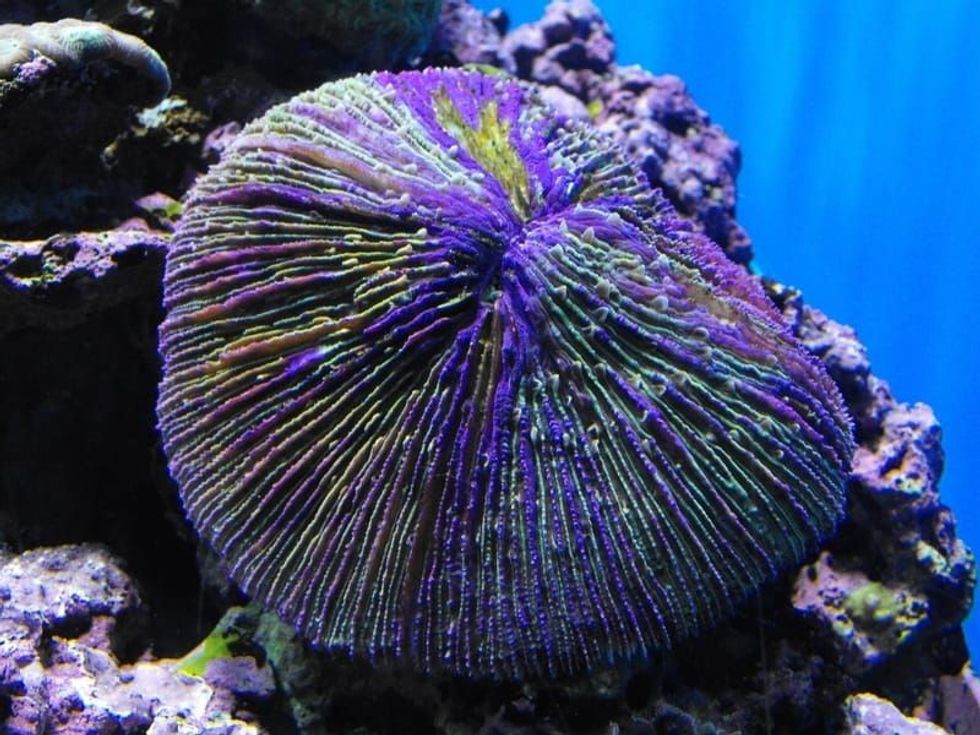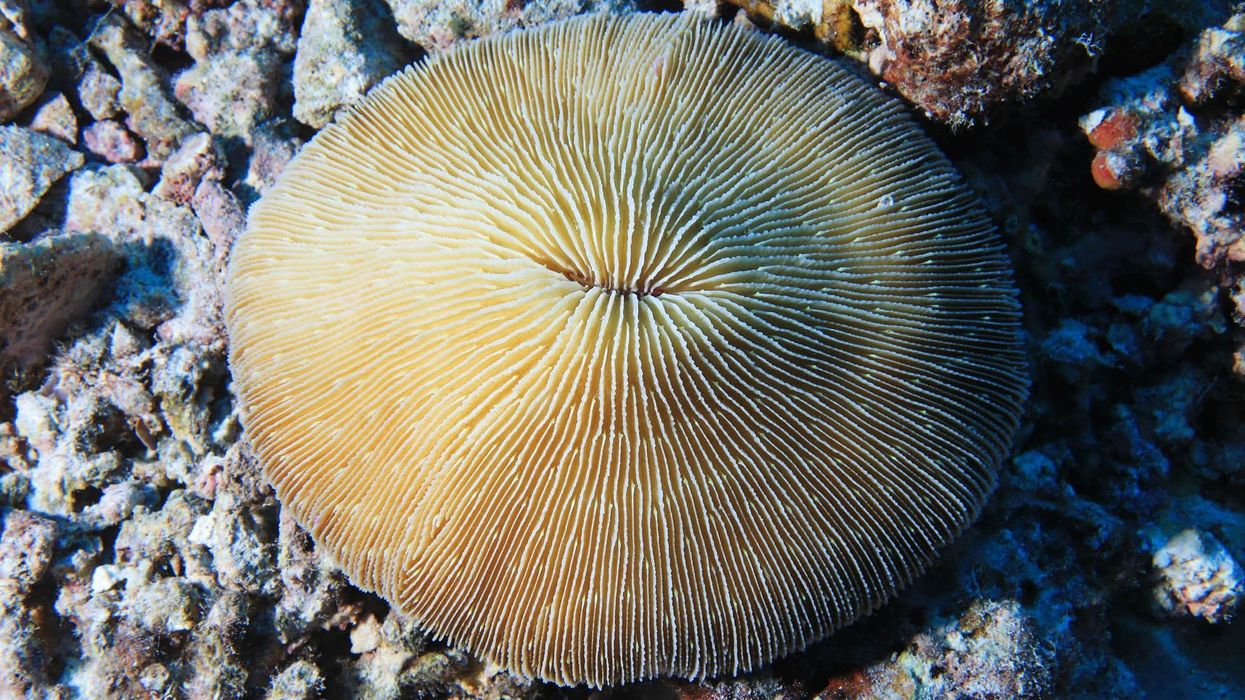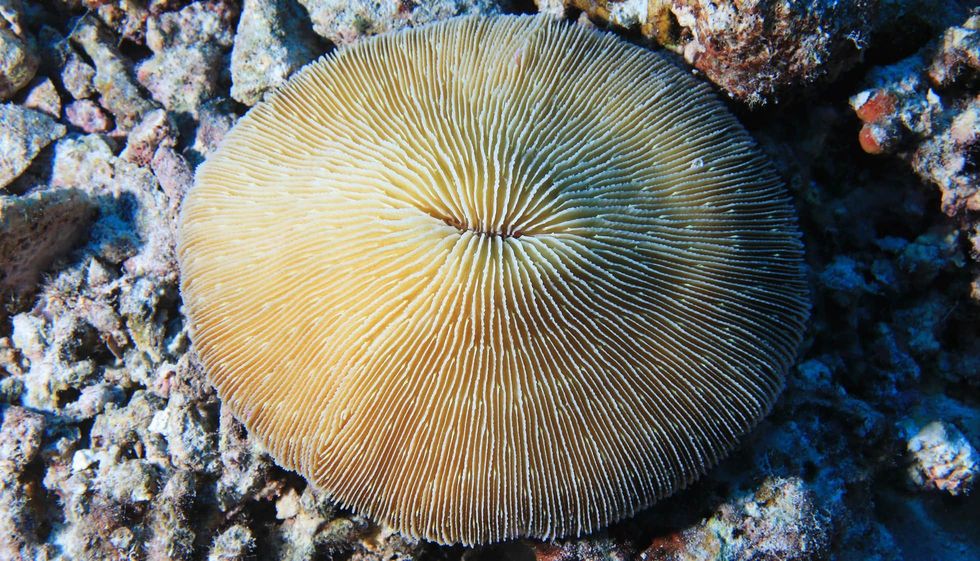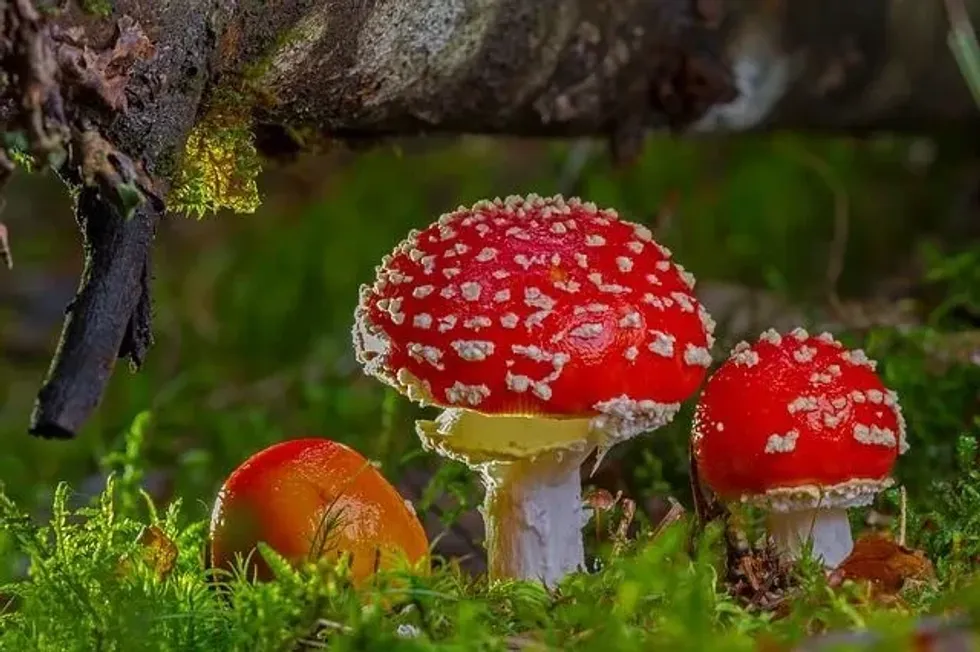Fun Mushroom Coral Facts Facts For Kids
Content
- What type of animal is a Mushroom Coral?
- What class of animal does a Mushroom Coral belong to?
- How many Mushroom Corals are there in the world?
- Where does a Mushroom Coral live?
- What is a Mushroom Coral's habitat?
- Who do Mushroom Corals live with?
- How long does a Mushroom Coral live?
- How does it reproduce?
- What is its conservation status?
- What do Mushroom Corals look like?
- How cute are they?
- How does it communicate?
- How big are Mushroom Corals?
- Can Mushroom Corals move?
- How much do Mushroom Corals weigh?
- What are their male and female names of the species?
- What would you call a baby Mushroom Coral?
- What does it eat?
- Is it harmful?
- Would it make a good pet?
- Did you know...
- How to care for Mushroom Coral
- How to frag Mushroom Coral
The mushroom corals, also known as Corallimorphs are a family of Cnidaria that live underneath the ocean. They belong to the Fungiidae family and are also sometimes referred to as Actinodiscus sp.
corals and hairy mushroom corals belong to the family of mushroom anemones.
There are several types of mushroom corals also known as disc anemones, giant cup coral mushroom family with the most popular types being called Ricordea florida and Ricordea yuma. Mushroom anemones and corals like Ricordea florida and Ricordea yuma are generally solitary marine animals capable of benthic locomotion while some are immobile as well as colonial.
Coral Ricordea florida and others are mostly collected as plate corals to keep them in reef aquariums. Actinodiscus sp.
corals, corals of the Ricordea family, Discosoma family, have been around for as long as hobbyists have been keeping their reef aquarium tanks.
The water in the aquarium should have moderate to low flow for corals like anemone corals, Discosma, and Ricordea to thrive along with some bright light. It is from the bright light itself that most corals of the Rhodactis and Ricordea family get their colors from.
There is a wide variety of the different types of mushroom coral and coral anemone and mushroom coral identification as per their appearance and family - like Ricordea, Discosoma, and the like is also very important.
If you are looking for some interesting facts about mushroom coral, you can check out this list of facts about bubble mushroom coral, bounce mushroom coral, orange mushroom coral, toadstool mushroom coral, elephant ear mushroom coral, elephant ear mushroom coral which looks like elephant ears, purple mushroom coral, disc anemones, mushroom anemones, giant cup corals, red mushroom coral, pink mushroom coral, hairy mushroom corals, and, green mushroom coral or Actinodiscus sp.
and more right here.
If you like our articles, you can check out other great articles on sea squirt or brain coral facts.
Mushroom Coral Interesting Facts
What type of animal is a Mushroom Coral?
Mushroom corals are a family of Cnidaria, often known as plate corals, and are known to be Corallimoprharians as per their taxonomic order.
What class of animal does a Mushroom Coral belong to?
Most varieties of the Mushroom coral belong to the class of Anthozoa however some belong to the class of Ricordea, Rhodactis, and Discosoma.
How many Mushroom Corals are there in the world?
There are 13 extant types of mushroom corals ranging from solitary to colonial species. The exact number, however, is quite overwhelming considering the number of coral reefs that are known to exist all around the world.
Where does a Mushroom Coral live?
The mushroom corals live in the ocean, soaked in saltwater. Most of the mushroom corals live in the Red Sea, Indian Ocean, Indo-west Pacific, the Gulf of Aden, and also around Southeast Asia, Australia, the East China Sea, and southern Japan.
Most coral species like Discosoma are popularly kept in a low-flow reef aquarium along with other tiny fish to elevate the wow quotient of a home.
What is a Mushroom Coral's habitat?
The mushroom coral is found on flat reefs, back reefs, lagoons, and reef slopes. It is always attached as a juvenile and free-living as an adult, and as a result, it is mobile.
Mushroom corals can only stay attached to their reef when they are small. When they get larger, they begin their life on the seafloor instead of a limestone pedestal.
Who do Mushroom Corals live with?
Mushroom corals can live as solitary corals such as Cycloseris and Fungia and also exist as colonial species such as corals like Herpolitha and Ctenactis.
How long does a Mushroom Coral live?
The various species of mushroom corals are known to thrive for more than 10 years. However, when it comes to the maturity of these coral reefs, most of these reef-building corals typically last for three to eight years with the average length of the generation being 10 years.
How does it reproduce?
Mushroom corals are asexual when it comes to reproduction and therefore occur in clusters. This species is also known to be one of the earliest colonizers that settled in the blasted areas and can also thrive in harsh environments.
Mushroom corals can reproduce sexually as well. They release gametes which is a combination of eggs and sperm into the water till they become fertilized embryos. However, their usual reproductive method is asexual in the reef tank which is also called fragmentation.
What is its conservation status?
Most mushroom corals are quite common and are even grown in reef aquariums with the process of fragging. However, some of the species of the mushroom corals are listed as Threatened as per the IUCN global listing.
Mushroom Coral Fun Facts
What do Mushroom Corals look like?
Mushroom corals are beautiful and brightly colored and come in a variety of hues, like red, purple, white, and beige in many shapes and sizes. Each polyp of the coral mushrooms has a slit at the center of its mouth.
They do not possess a skeleton unlike other mushroom corals and are known to have a chemical defense system that will extend out from their cap.
This can be harmful to other types of softer corals and SPS corals. They are mostly peaceful but they will try to outgrow and grow over any nearby corals.
Mushroom corals are named in accordance with their appearance and their colors.
There are many types of mushroom corals that possess tentacles as well and it is because of the possession of these tentacles they fall under the category of anemones. They are quite popular because of their bright and attractive appearance and are kept in aquariums.

How cute are they?
Not only are coral mushrooms beautiful to look at but also cute and adorable and make great additions in indoor reef aquariums with the unique colors of their polyp growths.
How does it communicate?
The mushroom corals release their particles in the water. Healthy corals use chemical signals or smells, to attract fish. New research has found that corals also send out 'distress' signals when they're in trouble.
How big are Mushroom Corals?
The mushroom corals are average in size. They are about 7 in big in size and 10 times bigger than other ocean animals such as snails.
Can Mushroom Corals move?
Yes, the mushroom corals can move to any preferred location, unlike other corals.
How much do Mushroom Corals weigh?
The entire colony of these mushroom corals can grow very large and therefore the weight is variable.
What are their male and female names of the species?
The names of their male and female species are unknown.
What would you call a baby Mushroom Coral?
Baby mushroom corals are the types of corals that are usually referred to as tiny corals.
What does it eat?
The algae within their body undergo photosynthesis to produce food from the light of the sun. The large mushroom corals usually feed on brine shrimp as a food supplement whereas the giant species of mushroom corals can easily capture small prey and fish.
Is it harmful?
The green hairy mushroom coral found in the Info-Pacific coral reefs may seem harmless but it is not. Not all corals are harmless. Some of them are known to possess a toxin, called palytoxin (PTX) which, if ingested, can lead to fatal hemorrhaging, respiratory reaction, and even death to humans.
Would it make a good pet?
Even though they are the lives of the ocean, they can also beautify your room if you keep them in an aquarium and care for them properly. But it is advisable not to touch them with bare hands.
Some of the mushroom corals are deadly to a human being.
But as long as they are kept in the tank and taken care of in a perfect manner, it is fine that they would make a good pet to beautify the aquarium. The Spotted Mushroom Coral is a beautiful, easier-to-care-for mushroom coral perfect for both novices and seasoned keepers of reefs.
Did you know...
The mushroom coral name is given to them because of their appearance which resembles a mushroom with a typical short or medium length of the stem, which is covered by a round cap that can sometimes be ruffled.
The Actinodiscus sp. corals as well as giant cup corals, hairy corals, are probably one of the easiest marine saltwater corals to find. Purple and reddish ones are widely available.
They have symbiotic photosynthetic zooxanthellae and require low to moderate lighting in order to produce foods. They also get nutrition by wasting their particles in the water. Sometimes they can eat small fishes too.
The large coral mushrooms can sometimes prey on smalls meats such as brine shrimp and algae as foods.
Coral Mushrooms are found throughout the world's oceans. Clustered coral is a widely distributed species in the world.
The Actinodiscus genus is of coral mushrooms is found in the Caribbean and the Indo-Pacific oceans in low currents and shallow to mid-depth waters closer to the surface. The Discosoma genus of coral mushrooms is found in pretty much all reefs in the Caribbean and the Indo-Pacific oceans in low current, mid-depth waters.
The Ricordea genus is found in the Atlantic and the Indo-Pacific on rocky surfaces, rubble, or growing vertically on dead corals.
The Corynactis genus is found in the Eastern Pacific and North Atlantic oceans in temperate waters. The Rhodactis species are found in the Central Indo-Pacific Ocean in shallow, bright waters down to low-light areas of the reef as well.
They have tracts of hair-like cilia on the disc surface of their skin that collect particles dropping from the seawater. The cilia help them to carry food to their mouth and to carry the sand.
Their main threats are climate change, pollution, and impacts from careless human activity such as trampling by careless visitors, and over-collection by hobbyists also have an impact on local populations.
The Sunflower mushroom coral and some other mushroom corals are listed as Threatened on the IUCN global listing.
Corals usually reverse their gender annually when they reach middle age. During their younger years, all males turn into females to develop their evolutionary fitness by retaining that gender for a few years.
How to care for Mushroom Coral
To care for the wide variety of the different types of corals, coral ricordea, corals of the rhodactis genus like green fuzzy coral mushrooms, red mushroom coral, elephant ear coral mushrooms and hairy coral mushrooms and anemones, disc mushroom corals, and the like, you need to set up a specific saltwater tank that has temperature control, water flow, and specific lighting.
The mushroom corals are used to low to medium light. Hence, you should keep them close to the bottom of the tank.
Special care should be taken when planning the tank to preserve these beautiful corals and also to help them thrive.
make sure that the water movement sources and the powerheads are not directed towards the mushroom corals. They cannot thrive when the water flow is significantly strong and they should also be given a significant amount of time or a few days to adapt to the tank environment.
You can also incorporate blue actinic light which helps in making the colors of the coral mushroom all the more vibrant and beautiful.
Coral mushrooms like the red mushroom coral, thrive when salinity levels are between 1.025-1.027, and water temperatures are stable between 77-79 degrees F. For long-term health, nitrates should be kept below 5 ppm and phosphates below 0.05 ppm.
The Actinodiscus classis can be taken care of easily and does not require high lighting levels. They should be kept in shaded areas in tanks with high output lamps, if not they turn all brown and fail to thrive.
The Discosoma family is easy to care for as well.
Moderate levels of lighting are perfect for this species. The Ricordea requires stronger lighting and water movement.
The species of Corynactis however, will not be able to handle strong water flow and also requires little light and needs to be hand-fed during the night because they are nocturnal.
The Amplexidiscus species is easy to care for and is not finicky as far as light and water movement, although it does better in moderate lighting in the tank. The Rhodactis family is one of the easiest coral species to care for because they can require moderate to high levels of lighting as per the type of the species.
However, high lighting is not imperative for their survival.
How to frag Mushroom Coral
In order to frag the coral mushrooms in the tank, use a small rectangular chopping board or a pot for holding the corals in the tank water. Take the coral out of the tank and sever it from the rock it has attached itself to.
Then, with a sharp knife cut the coral from the column, and leave the disc alone. Rinse the fragged corals before adding them into the tank water.
Here at Kidadl, we have carefully created lots of interesting family-friendly animal facts for everyone to discover! Learn more about some other arthropods from our sand dollar fun facts for kids, and sea nettle surprising facts pages.
You can even occupy yourself at home by coloring in one of our free printable mushroom coral coloring pages.
We Want Your Photos!
More for You
Bachelor of Arts specializing in Journalism and Mass Communication, Postgraduate Diploma in Sports Management

Moumita DuttaBachelor of Arts specializing in Journalism and Mass Communication, Postgraduate Diploma in Sports Management
A content writer and editor with a passion for sports, Moumita has honed her skills in producing compelling match reports and stories about sporting heroes. She holds a degree in Journalism and Mass Communication from the Indian Institute of Social Welfare and Business Management, Calcutta University, alongside a postgraduate diploma in Sports Management.
Disclaimer
1) Kidadl is independent and to make our service free to you the reader we are supported by advertising. We hope you love our recommendations for products and services! What we suggest is selected independently by the Kidadl team. If you purchase using the Buy Now button we may earn a small commission. This does not influence our choices. Prices are correct and items are available at the time the article was published but we cannot guarantee that on the time of reading. Please note that Kidadl is a participant in the Amazon Services LLC Associates Program, an affiliate advertising program designed to provide a means for sites to earn advertising fees by advertising and linking to Amazon. We also link to other websites, but are not responsible for their content.
2) At Kidadl, we strive to recommend the very best activities and events. We will always aim to give you accurate information at the date of publication - however, information does change, so it’s important you do your own research, double-check and make the decision that is right for your family. We recognise that not all activities and ideas are appropriate for all children and families or in all circumstances. Our recommended activities are based on age but these are a guide. We recommend that these ideas are used as inspiration, that ideas are undertaken with appropriate adult supervision, and that each adult uses their own discretion and knowledge of their children to consider the safety and suitability. Kidadl cannot accept liability for the execution of these ideas, and parental supervision is advised at all times, as safety is paramount. Anyone using the information provided by Kidadl does so at their own risk and we can not accept liability if things go wrong.
3) Because we are an educational resource, we have quotes and facts about a range of historical and modern figures. We do not endorse the actions of or rhetoric of all the people included in these collections, but we think they are important for growing minds to learn about under the guidance of parents or guardians.







